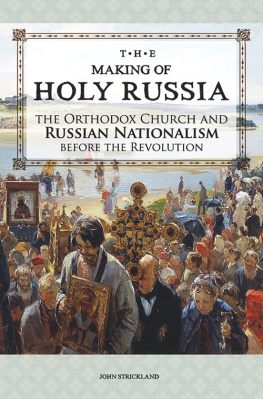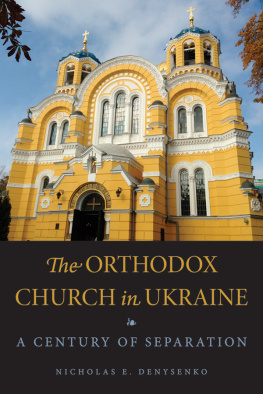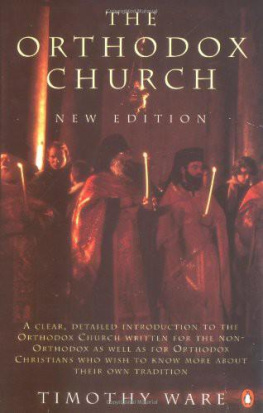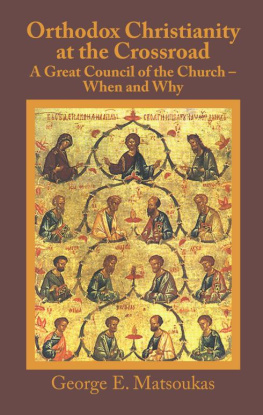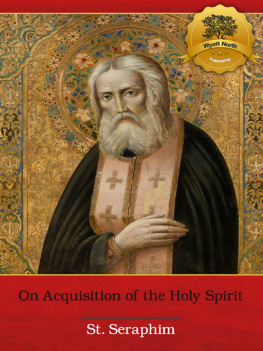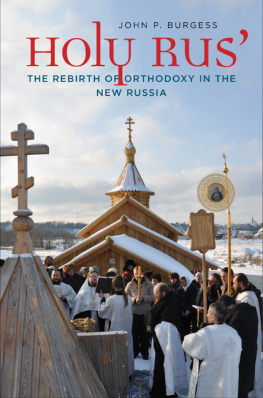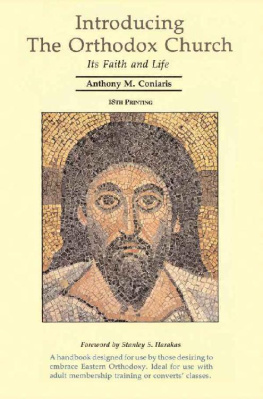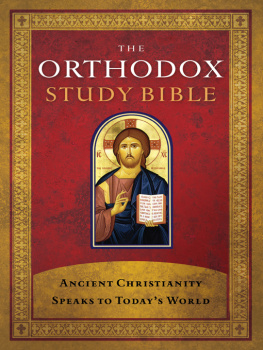The Making of Holy Russia
The Orthodox Church and Russian Nationalism
before the Revolution
John Strickland
Holy Trinity Publications
The Printshop of St Job of Pochaev
Holy Trinity Monastery
Jordanville, New York
2013

Printed with the blessing of His Eminence,
Metropolitan Hilarion First Hierarch
of the Russian Orthodox Church Outside of Russia

The Making of Holy Russia
2013 John Strickland

HOLY TRINITY PUBLICATIONS
The Printshop of St Job of Pochaev
Holy Trinity Monastery
Jordanville, New York 13361-0036
www.holytrinitypublications.com
Cover Art: Easter Procession by Illarion Michajlowitsch Pryanishnikov, 1893.
Source: DIRECT MEDIA Zenodot Verlagsgesellschaft mbH.
Cover Design: James Bozeman
ISBN: 978-0-88465-329-5 (paperback)
ISBN: 978-0-88465-346-2 (hardback)
ISBN: 978-0-88465-347-9 (ePub)
ISBN: 978-0-88465-348-6 (Mobipocket)
Library of Congress Control Number 2013938140
Scripture passages taken from the New King James Version.
Copyright 1982 by Thomas Nelson, Inc. Used by permission.
All rights reserved.
Printed in the United States of America
CONTENTS
For my parents
Gordon and Jananne Strickland
My professional training in history would have been inconceivable
without their unconditional love and support,
and it is to them that I dedicate this book.
FOREWORD
T his work originated as a doctoral dissertation researched in libraries and archives of St Petersburg, Russia, where the author lived for two years in the late 1990s. It takes the form of an extended commentary upon ideas and teaching about national identity advanced within the Orthodox Church in Russia in the closing decades of the nineteenth century and the early twentieth century leading up to the tragedy of the Bolshevik Revolution in 1917.
In particular it draws attention to the voices of those whom the author terms Orthodox patriots, both clergy and laity, who advocated for the place of the Church as a unifying force, central to the identity and purpose of the increasingly diverse Russian Empire. Their views were articulated not only in numerous publications and administrative decisions, but through art and architecture. They sought to realize a vision of a both temporal and transcendent Holy Russia that could be God's instrument for the salvation of all nations and overcome the limitations of the sociopolitical entity known as the Russian Empire.
These voices were both persistent and widely expressed, yet have received little attention in studies of the history of Russia during this period. This is perhaps because they are less readily understood by writers more intrinsically sympathetic to the Western intellectual traditions of modern nationalism or liberal thought.
Grounded in original research, this study is nevertheless intended for a broader audience than that of most academic works. It is written in light of the historical path Russia has taken since the fall of communism in 1991, and the significant role the Orthodox Church now plays in defining and leading national life.
Such a role is reflected very clearly in the concluding statement of the February 2013 Bishops' Council that met in Moscow. In it the Bishops declared,
Orthodoxy is being reborn as the foundation of national self-consciousness, uniting all the healthy forces in societythose forces which strive for the transformation of life on the basis of a sure foundation and the spiritual and moral values that have entered the flesh and blood of our peoples.
Notwithstanding this declaration, many questions remain as to the extent to which Orthodoxy is being fully embraced in contemporary Russian life both in the homeland and abroad. Furthermore, the exact relationship between the Church as the universal earthly manifestation of a heavenly society and post-Enlightenment conceptions of nationhood remains problematic in practice and presents an ongoing pastoral and missionary challenge.
It is therefore to be hoped that this historical study might ignite a contemporary debate that can lead to greater clarity and prayerful action in conveying the everlasting Gospel of salvation in Christ through His Church to all peoples.
Holy Trinity Monastery
Jordanville, New York
INTRODUCTION
HOLY RUS AND MODERN RUSSIA
O n July 20, 1914, Tsar Nicholas II stepped out onto the balcony of the Winter Palace in St Petersburg to announce the Russian Empire's entry into the First World War. Below him on Palace Square stood a great crowd of patriotic Russians, who fell into a hush as he began to read the war manifesto. The scene was similar to those in other European capitals during the first days of the war. In each case, rulers appealed to national traits that would sustain the sacrifices ahead. And in each case the news was received with broad support, uncanny in light of the catastrophe that the war ultimately brought.
In St Petersburg, the tsar solemnly spoke of a national community called Holy Rus (sviataia Rus). This community represented the core of Russia (Rossiia), he suggested, and was constituted by a self-conscious devotion to Orthodox Christianity and a common ethnic ancestry. It was constituted, in other words, by faith and blood. Tsar Nicholas said that in the coming time of war, ultimate victory would depend on the conviction that modern Russia was in fact equivalent to Holy Rus. The words of his war manifesto were deeply moving to those assembled below. As he finished reading it, they sank to their knees and began singing the patriotic Orthodox hymn, O Lord Save Thy People.
Nicholas II (r. 18941917) was compelled to invoke the image of Holy Rus because Russia and her imperial system, which for decades had been plagued by instability, lacked the unity needed for total warfare. As such, his war manifesto drew upon a long tradition that can be called Orthodox patriotism. It claimed that Russia possessed a national character rooted in the Orthodox Christian faith, which it was her destiny to preserve and disseminate. The First World War did not bring about the fulfillment of the ideals of Orthodox patriotism, and less than three years after the tsar's Palace Square address, revolution swept away the hope that modern Russia was indeed Holy Rus.
Though never subjected to a comprehensive study, Orthodox patriotism has profoundly shaped the history of Russian culture and thought, and its manifestations are often a part of even the most cursory historical surveys. Significantly, the earliest proponents were members of the Orthodox clergy. Within a century of the foundation of Christianity under Grand Prince Vladimir (r. 9801015), for example, Russia's first native Church primate, Metropolitan Ilarion of Kiev (r. 10511055), declared that the Russian people were the successors to the ancient Israelites in that they were a national-community that had become the bearers of the true faith in history. Following the collapse of the Byzantine Empire in 1453, the Pskovian monk-Filofei (14601542) embellished the ideal further by claiming that the Muscovite state, as the Third Rome, had been given a messianic destiny to preserve the Orthodox faith in the face of the apostasy of Rome and the fall of Constantinople, the Second Rome. Filofei's doctrine was supplemented by other Muscovite Church leaders such as Metropolitan Macarius (14821563), who in the sixteenth century wrote influential works about the state's Orthodox character and promoted the canonization of large numbers of national saints. Likewise, the leadership of the Old Believers, when confronted by the Church reforms of Patriarch Nikon during the seventeenth century, claimed to preserve Russian national character by retaining unaltered what they considered the true faith. In short, there can be little argument that the identification of Russian nationality with the Orthodox faith found its earliest elaboration among representatives of the clergy.

